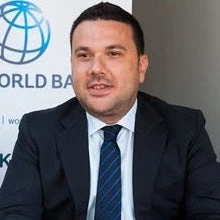 Cover graphic from the Supporting Serbia’s Transition to Greener and More Resilient Growth report
Cover graphic from the Supporting Serbia’s Transition to Greener and More Resilient Growth report
As the European Union forges ahead on a development path paved by the European Green Deal, can Serbia, an EU candidate country, keep up with the initiatives of its neighbors and build a green future? What reforms could help transition the country's economy—now among Europe's most energy-intensive and with pollution a heavy burden on public health—toward more sustainable and resilient growth?
A recent World Bank report, Supporting Serbia’s Transition to Greener and More Resilient Growth, suggests that the country needs action in three areas: (1) get prices to reflect the cost of pollution and wasteful use of resources; (2) undertake sectoral reforms to support green transition priorities, and (3) strengthen national institutions to support the green reform agenda.
It is important to acknowledge that Serbia’s green transition aspirations are not only driven by its EU accession ambition. The government has reaffirmed its commitment to global climate action under the Paris Agreement, updating its emissions reduction target for 2030 to 33.3% compared to 1990 levels. Serbia has also made regional commitments under the Green Agenda for the Western Balkans, like the Sofia Declaration, which goes beyond decarbonization and highlights the importance of depollution, the circular economy, biodiversity, and sustainable food systems.
The Role of Prices
Given its strong trading ties with the EU, Serbia needs to prepare to align itself with the EU’s climate ambitions. The EU Carbon Border Adjustment Mechanism (CBAM), expected to be introduced in 2026, will impose a fee on the carbon content of selected goods imported into the EU from countries without comparable climate policy ambition. Macroeconomic simulations presented in the report show that CBAM will have a small impact on Serbia’s economy overall—but could have a significant adverse impact on the country’s emissions-intensive sectors.
Ultimately, the introduction of CBAM will produce winners and losers: high-value, lower-carbon products would benefit, while more carbon-intensive and trade-exposed sectors would shrink without an adequate policy response. For example, CBAM as proposed today, could reduce Serbia’s steel production by around a third by 2035.
The implementation of carbon pricing based on the EU Emissions Trading System would enable Serbia to proactively prepare for the forthcoming CBAM and offer a less costly path to green reforms. As a contracting party of the Energy Community, Serbia adopted the Decarbonization Roadmap, committing to establish the necessary regulatory framework to implement carbon pricing by 2026. Adopting carbon pricing would also generate fiscal revenue that could be used domestically to incentivize investments in new, more productive economic sectors with lower carbon intensity, boosting GDP. In addition to avoiding the imposition of hefty duties on its carbon-intensive exports to the EU, putting a price on carbon domestically would result in a 38% reduction in total national GHG emissions. If the revenues from broader carbon pricing reforms were reinvested in innovation and education, this could also facilitate a structural shift to a more productive economy.
Sectoral Reforms
The report makes the case that while a broad set of reforms is needed to support the transition to greener and more resilient growth in Serbia, certain sectoral reforms—which could address the immediate priorities of the Serbian population, including air pollution, waste management, and energy efficiency—are already within reach.
Serbia needs to strengthen legislation on the full range of air quality issues. This would include the adoption of a new Law on Air Protection, and support for specific emissions reduction targets in the energy, industrial, and transport sectors, as well as the often-ignored emissions arising from agricultural practices.
Improving waste management is also integral to Serbia’s green transition. The country could start by supporting the ongoing Circular Economy Development Program 2022-24 and advance implementation of the Waste Management Program 2022-2031.
Energy efficiency requires work, too. Several important laws and regulations on energy efficiency were approved in 2021 yet their implementation remains patchy. The recently created Administration Unit for Energy Efficiency Financing and Promotion is a step in the right direction.
Reforms are also needed to finance green sectoral interventions. Using fiscal reforms as an example, the report highlights that additional financing needs can be met by adopting the ‘polluter pays’ principle, making those who pollute responsible for the cost of impacts to the environment and human health.
Stronger Institutions
A stronger institutional framework is vital for a more sustainable Serbian economy and meeting the country’s various international commitments. For instance, once Serbia decides to adopt its own carbon pricing system, the country will need to have a robust measurement, reporting and verification (MRV) framework for GHG emissions—a process in place to measure the GHG emissions reduced by mitigation activities over a timeframe and report these findings to an accredited third party for verification.
The report makes specific recommendations to address the institutional challenges to reduce air pollution and implement the newly adopted National Air Protection Program 2022-2030, as well as climate change mitigation to implement the 2021 Law on Climate Change and its bylaws. It stresses the need for cross-sectoral coordination, policy coherence across sectors, and deepened engagement with businesses and citizens.
Through sectoral reform, pollution pricing, and measures to strengthen institutions, Serbia will support its green transition efforts, boost the country’s resilience to climate change, and improve health and wellness for the Serbian people.



Join the Conversation